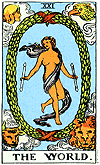This is a blog about nature in all her glory. The folklore and general ideas about what messages nature bring to people.
Friday, August 26, 2016
Tarot: Patterns of the Major Arcana, "The Hero's Journey," and Others
The patterns in the Major Arcana set up by Teresa Michelsen in The Complete Tarot Reader and that of Arlene Tognetti and Lisa Lenard in The Complete Idiot’s Guide to Tarot and Fortunetelling are variations on the traditional Fool’s Journey of the Tarot. What each author did was to split their cards into groups to make this journey more understandable for themselves. Each group embraces a particular concept which is helpful to these Tarot authors. Each of the two patterns start with a young person meeting significant people and facing challenge. After wrestling with problems, young person matures and emerges in the world spiritually enlightened. The various groupings help the reader to understand The Fool’s Journey in depth by placing focus on particular parts of it from varying points of view.
Meanwhile, Robert Place in The Tarot History, Symbolism, and Divination sees the Major Arcana differently. For him, it is not a journey, but a focus on particular aspects of the person. In his patterns, Place sets up Plato’s Three Parts of the Soul. Appetite, the first part of the soul, is represented by The Magician through The Chariot. These cards depict the desires a person has such as seeking power or love. The next group, which is Strength to Temperance, represents the Will (Spirit), the second part of the soul. These cards focus on the emotions such as seeking solitude or justice. The final group – The Devil to The World – represent Reason, the third part of the Soul. These cards highlight the mind, which Plato placed as the highest part of the soul.
Two patterns that I developed could probably be considered variations on The Fool’s Journey. The first is based on the therapeutic model of moving from illness to wellness. The Magician to The Hierophant are the various perceptions of reality, ranging from “mind over matter” to “strict rules of life.” The next group, The Lovers to Justice, are the issues of life that everyone has to cope with from changing homes to bad luck. The Hanged Man to The Tower are the struggles for people to overcome their distorted thinking and misperceptions. From The Star to The World are the rewards of healthy thinking and wellness, which only happens when the person implements these changes in their life.
The other pattern was inspired by Journey to the Dark Goddess by Jane Meredith. This Journey is to the Underworld to meet the Dark Goddess. There, the person reclaims the lost and dark parts of themselves. Meredith says that we cannot go to the Dark Goddess while we are still in our place in the world. First, we have to be stripped of everything that we value. Once in the Underworld, we meet the Dark Goddess, who holds these remnants of our selves. Whilst in the Underworld, we are dead until a turning point occurs to restore us to life. This propels us upward. Afterwards, we become whole and emerge back into the Upper World reborn.
This particular Journey has four parts. The first is “Preparing for Descent.” The Magician through The Lovers are who we are in the Upper World. We have to give up all of this to undertake the second part, which is “The Descent to the Underworld.” The Chariot to Justice denotes our removal of our status and our acceptance of our fate. The third part is “Dwelling in the Underworld.” Like the Hanged Man, we are limbo as we die. Death to The Devil explains our time in the Underworld. The turning point for “The Ascent,” the fourth part, is The Tower. When we return to the Upper World we gain The Star through Judgement. Now as The World, we are reborn.
Arranging the cards into patterns helped me to see how various processes occur in the Tarot. Each pattern highlights a different aspect of the Major Arcana. Within each pattern, I can understand how each card relates to the others such as why is Temperance between Death and The Devil. When a number of them from a group appear in a reading, the reader can figure out where the questioner is in the process.
Works Used:
Lorenz, Hendrick, “Ancient Theories of the Soul.” Stanford Encyclopedia of Philosophy. 22 April 2009. Web. http://plato.stanford.edu/entries/ancient-soul/ .
Meredith, Janet, Journey to The Dark Goddess. Moon Books: Winchester (UK). 2012. Print.

No comments:
Post a Comment